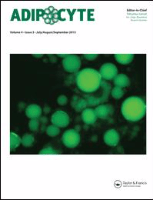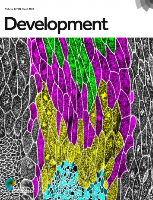
Adipocyte
Scope & Guideline
Unlocking the Mysteries of Adipose Biology
Introduction
Aims and Scopes
- Adipose Tissue Biology:
Research on the cellular and molecular mechanisms underlying adipocyte function, differentiation, and metabolism. - Obesity and Metabolic Disorders:
Investigations into the role of adipose tissue in obesity, insulin resistance, and related metabolic diseases. - Adipokines and Signaling Pathways:
Exploration of adipokines and their signaling pathways, examining their effects on systemic metabolism and disease progression. - Stem Cell Research in Adipogenesis:
Studies on adipose-derived stem cells, their differentiation potential, and their applications in regenerative medicine. - Technological Innovations in Adipose Research:
Development and application of new methodologies and technologies for studying adipose tissue, including bioinformatics and imaging techniques. - Clinical Implications of Adipose Research:
Research that connects basic science findings with clinical outcomes, particularly in the context of obesity-related diseases and therapies.
Trending and Emerging
- Molecular Mechanisms of Adipocyte Function:
An increasing emphasis on understanding the molecular pathways that regulate adipocyte function, including gene expression, signaling cascades, and metabolic regulation. - Adipose Tissue and Cancer Interactions:
Emerging research on the role of adipose tissue in cancer biology, including how adipocytes influence tumor progression and the metabolic interplay between fat tissue and cancer cells. - Therapeutic Targets in Adipose Tissue:
A trend toward identifying novel therapeutic targets within adipose tissue, focusing on potential interventions for obesity and metabolic diseases. - Innovative Biomarkers for Obesity-Related Diseases:
Research increasingly focuses on discovering and validating biomarkers derived from adipose tissue that could predict disease severity and treatment outcomes. - Interplay Between Immune Function and Adipose Tissue:
Growing interest in the interactions between the immune system and adipose tissue, particularly how inflammation in adipose tissue contributes to metabolic diseases. - Technological Advancements in Adipose Research:
A surge in the application of cutting-edge technologies, such as CRISPR gene editing, advanced imaging techniques, and bioinformatics tools, to study adipose tissue biology.
Declining or Waning
- Basic Physiological Studies on Adipose Tissue:
There has been a noticeable decline in purely descriptive studies that focus solely on the basic physiological characteristics of adipose tissue without integrating them into broader metabolic contexts. - Studies on Traditional Weight Loss Interventions:
Research focusing on conventional weight loss strategies and their direct effects on adipose tissue has diminished, possibly due to the emergence of more complex metabolic understandings. - Single-Cell Analysis of Adipose Tissue:
Although initially a growing area of interest, the frequency of publications focusing exclusively on single-cell transcriptomics or proteomics in adipose tissue has decreased as researchers integrate these approaches into broader multi-omics studies. - Animal Models of Obesity without Translational Relevance:
There appears to be a reduction in studies using animal models that do not translate well to human conditions, as there is a growing emphasis on studies that bridge basic research with potential clinical applications.
Similar Journals

TRENDS IN CELL BIOLOGY
Elevating Research Standards in Cell BiologyTRENDS IN CELL BIOLOGY, published by CELL PRESS, is a premier journal in the field of cell biology, recognized for its high-impact contributions since its inception in 1991. As a distinguished member of the Q1 quartile within its category, the journal holds an impressive Scopus ranking of #8 out of 285, placing it in the 97th percentile of the field, which underscores its reputation for excellence. The journal serves as an essential resource for researchers, professionals, and students who are engaged with groundbreaking advancements in biochemistry, genetics, and molecular biology. Although it is not open access, it provides critical insights into the latest trends, reviews, and advancements in cell biology, making it a crucial tool for anyone committed to understanding the complexities of cellular systems. With a focus on innovative and transformative research, TRENDS IN CELL BIOLOGY continues to shape the discourse in cell biology and enhance the scientific community's knowledge.

JOURNAL OF MOLECULAR HISTOLOGY
Advancing the frontiers of cellular insight.The Journal of Molecular Histology, published by Springer, stands at the forefront of multidisciplinary research in cellular and molecular histology, offering vital contributions in the fields of Cell Biology, Histology, and Medicine. With an ISSN of 1567-2379 and an E-ISSN of 1567-2387, this peer-reviewed journal has maintained its commitment to advancing knowledge since its inception in 2004 and continues to thrive into 2024. The journal, located in The Netherlands, boasts a robust impact within its categories, currently holding Q3 rankings in Cell Biology and Q2 rankings in Histology, Medicine, and Physiology, highlighting its relevance to academics and professionals alike. With Scopus rankings that reflect a strong percentile presence across multiple fields, the journal emphasizes open access options to enhance the dissemination of critical research findings. As a valuable resource for researchers, professionals, and students engaged in molecular exploration, the Journal of Molecular Histology fosters innovation and collaboration, making significant impacts on our understanding of tissue structure and function.

FOLIA HISTOCHEMICA ET CYTOBIOLOGICA
Innovating Insights into Disease Mechanisms and Biological ProcessesFOLIA HISTOCHEMICA ET CYTOBIOLOGICA, an esteemed journal published by VIA MEDICA, serves as a vital platform for researchers and professionals in the fields of histology, pathology, and cytobiology. With an ISSN of 0239-8508 and E-ISSN of 1897-5631, this Open Access journal has been disseminating significant findings since 1984, offering free access to a broad audience of scientists and academics. Based in Poland, this journal focuses on critical advancements in the study of cellular structures and functions, contributing substantially to the understanding of various diseases and biological processes. The journal currently holds a respectable impact factor, ranking in the Q3 category for Histology and miscellaneous Medicine, and Q2 for Pathology and Forensic Medicine as per the 2023 metrics. With its commitment to quality research and an inclusive publishing approach, FOLIA HISTOCHEMICA ET CYTOBIOLOGICA is poised to continue influencing its fields significantly through 2024 and beyond.

CELLULAR & MOLECULAR BIOLOGY LETTERS
Unlocking the Secrets of Life at the Molecular LevelCELLULAR & MOLECULAR BIOLOGY LETTERS, published by BMC, is a premier open-access journal dedicated to disseminating high-quality research in the fields of Biochemistry, Cell Biology, and Molecular Biology. Established in 1996, the journal has emerged as a leader in its domain, boasting an impressive Q1 ranking across three critical categories as of 2023, reflecting its significant impact within the scientific community. With an ISSN of 1425-8153 and an E-ISSN of 1689-1392, it offers accessible research findings to a global audience, having been open access since 2013. Situated in the United Kingdom, at CAMPUS, 4 CRINAN ST, LONDON N1 9XW, the journal continues to serve as a vital resource for researchers, professionals, and students, contributing to advancements in the understanding of cellular and molecular processes. By providing a platform for original research, reviews, and short communications, CELLULAR & MOLECULAR BIOLOGY LETTERS plays a crucial role in fostering dialogue and collaboration within the scientific community.

Autophagy
Unlocking the Secrets of Cellular RecyclingAutophagy is a premier peer-reviewed journal published by Taylor & Francis, Inc. in the United States, focusing on advances in the fields of Cell Biology and Molecular Biology. With an impressive impact factor reflected in its Q1 ranking in both categories, Autophagy stands as a vital resource for researchers and professionals dedicated to understanding the intricate mechanisms of cellular degradation and recycling. The journal has been a cornerstone of scientific communication since its inception in 2005, continuing to flourish through 2024, fostering collaboration and innovation in the study of autophagic processes. Although it does not currently offer Open Access options, the journal remains highly regarded for its rigorous peer-review process and its commitment to publishing high-quality, impactful research. By bridging fundamental research with clinical applications, Autophagy plays a crucial role in advancing our understanding of various diseases, making it an essential tool for scholars and practitioners in the biomedical field.

BMC Molecular and Cell Biology
Exploring the depths of cellular mechanisms and molecular interactions.BMC Molecular and Cell Biology is a forward-thinking open-access journal published by BMC, specializing in the vital fields of molecular biology and cell biology. Since its inception in 2019, the journal has carved a niche for itself, ranking in the Q3 quartile in both Cell Biology and Molecular Biology categories as of 2023. With an ISSN of N/A and an E-ISSN of 2661-8850, the journal provides a platform for groundbreaking research, high-quality reviews, and innovative methodologies. Situated in the United Kingdom, BMC Molecular and Cell Biology promotes a diverse range of studies, addressing fundamental questions in biology that resonate with both experts and new researchers alike. The journal's commitment to open access ensures that valuable findings are readily available to the global scientific community, fostering collaboration and knowledge-sharing across disciplines. Researchers aiming to contribute to the field of cell and molecular biology will find this journal an indispensable resource for both publishing and staying informed on the latest advances.

CELL PROLIFERATION
Pioneering Research for a Healthier TomorrowCELL PROLIFERATION, published by Wiley, is a leading open-access journal that has been at the forefront of research since its inception in 1968. With an impact factor that solidifies its position in the Q1 category of both Cell Biology and Medicine (Miscellaneous), this journal serves as a premier platform for disseminating groundbreaking studies in the field of cellular and molecular biology. The journal is renowned for its rigorous peer-review process and comprehensive coverage of topics related to cell growth, division, and differentiation, making it an invaluable resource for researchers, professionals, and students alike. With its notable Scopus ranking of #30 in Biochemistry, Genetics, and Molecular Biology: Cell Biology, and a robust open access model since 2019, CELL PROLIFERATION ensures that cutting-edge research is accessible to a global audience, fostering collaboration and innovation across the scientific community. Located in the United Kingdom, the journal remains committed to enhancing the understanding of cellular processes, thereby influencing developments in medicine and biotechnology.

AMERICAN JOURNAL OF PHYSIOLOGY-CELL PHYSIOLOGY
Unveiling Cellular Mechanisms for Tomorrow's Discoveries.Welcome to the American Journal of Physiology-Cell Physiology, a premier publication produced by the American Physiological Society that has been a cornerstone of research in cell biology and physiology since its inception in 1977. With its esteemed reputation solidified by its Q1 ranking in both Cell Biology and Physiology categories as of 2023, this journal serves as a vital resource for researchers, professionals, and students pursuing cutting-edge discoveries in cellular mechanisms. The journal is published in the United States and is recognized for its rigorous peer-review process, contributing to its high impact factor and prestigious standing—ranking #32 out of 193 in Physiology and #75 out of 285 in Cell Biology according to Scopus. While the journal does not provide open access, it remains an essential repository of knowledge, fostering innovation and advancing the field with original research articles, reviews, and commentaries. Join us in exploring the molecular intricacies of life through the compelling research that the American Journal of Physiology-Cell Physiology has to offer.

DEVELOPMENT
Illuminating the path of development from molecules to organisms.DEVELOPMENT is a preeminent journal published by COMPANY BIOLOGISTS LTD, headquartered in the United Kingdom. With an ISSN of 0950-1991 and an E-ISSN of 1477-9129, this esteemed journal has been at the forefront of the fields of Developmental Biology and Molecular Biology since its inception in 1987. Recognized for its rigorous peer review process and high-caliber research, DEVELOPMENT holds an impressive Q1 ranking in both disciplines as of 2023, underscoring its pivotal role in advancing scientific understanding. The journal is particularly noted for its contributions to the understanding of developmental processes, their molecular underpinnings, and their implications in health and disease. With a significant impact factor, DEVELOPMENT aims to disseminate groundbreaking research that inspires novel insights and future explorations within the biological sciences, making it an essential resource for researchers, professionals, and students alike. The journal also maintains accessibility for its readership, ensuring that significant research findings reach those who can apply and build upon them.

Cell and Bioscience
Empowering Knowledge Sharing in Molecular BiologyCell and Bioscience is a prestigious open-access journal published by BMC that has been at the forefront of biochemistry, genetics, and molecular biology since its inception in 2011. With an impressive impact factor, this journal has established itself as a vital resource for researchers and professionals in these rapidly advancing fields, reflecting its high ranking of #29 out of 221 in the Scopus classification and placing it in the 87th percentile. Based in the United Kingdom, Cell and Bioscience aims to foster innovation and dissemination of research findings addressing critical biological questions through rigorous peer-reviewed articles and inter-disciplinary approaches. The journal's open-access model ensures unrestricted access to transformative research, promoting collaboration and knowledge sharing among academics, students, and practitioners worldwide. With a commitment to maintaining excellence in the field, Cell and Bioscience provides an essential platform for those looking to contribute to the evolving landscape of biosciences.